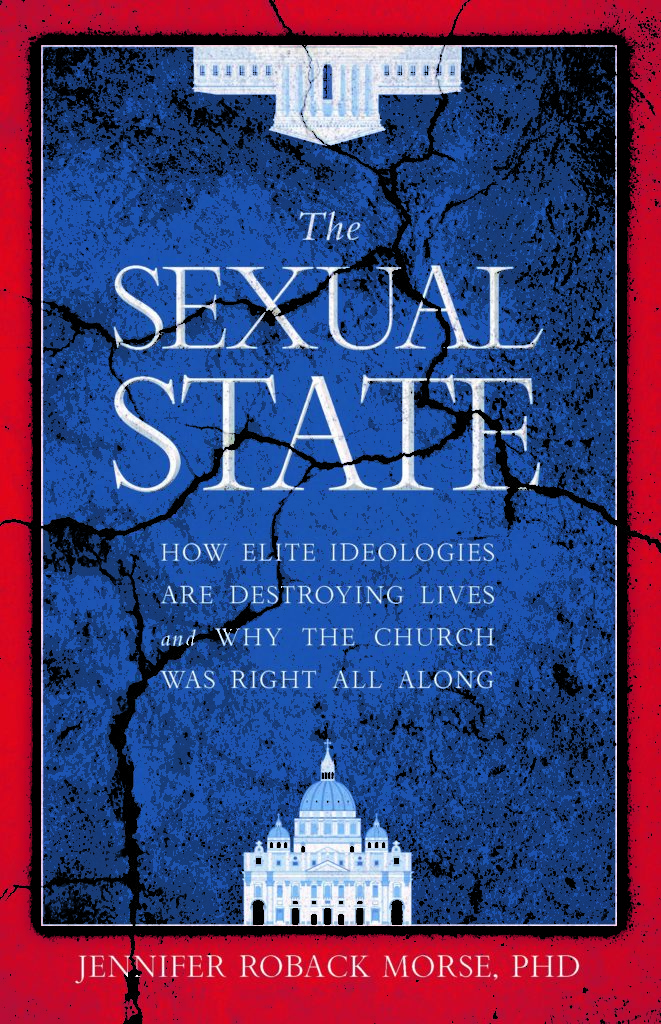By Tyler O’Neil
This article was first published October 4, 2018, at PJMedia.com.

In 21st century America, sex is all around us: on television, in movies, in classrooms, in politics, and even in churches. Sex permeates our desires, our expectations for relationships, even our identity. The Sexual Revolution goes far beyond the LGBT movement, and it has fundamentally reshaped American society. But few Americans actually grasp exactly where this revolution came from. An explosive new book reveals that government and wealthy donors, rather than impersonal historical forces or newly liberated women, propelled the Sexual Revolution.
“The State bears the greatest responsibility for the toxic sexual culture in which we live,” Jennifer Roback Morse, founder of the Ruth Institute (RI), writes in “The Sexual State: How Elite Ideologues Are Destroying Lives And Why the Church Was Right All Along.” She presented five other explanations for the Sexual Revolution, and found each one wanting.
Many have suggested that the Sexual Revolution came about through the inevitable and impersonal “march of history.” This view does not work “because it robs us and our forbears of human agency.” Even the over-hyped birth control pill “is just an inert piece of technology” that people could decide to use or not use, or use in different ways.
Morse also rebuts the feminist narrative, which suggests that “these changes have been one long string of victories for the benefit and advancement of women.” Ironically, the very success of women’s liberation “undermines the claim that women have been completely powerless and dominated by the patriarchy throughout all of recorded history.” Furthermore, the author argues that “the pro-life movement is dominated by women,” suggesting that not all women want more of the Sexual Revolution.
Perhaps the most common explanation for the Sexual Revolution is the “liberationist narrative,” which posits that everyone is more free thanks to new sexual norms. This view also cannot explain how age-old oppression was immediately dissolved in one generation, Morse argues.
Furthermore, many people “have become less free, in fact actually oppressed, by the very forces that are supposedly liberating us. The breaking of family bonds has increased the size and scope of the State, including the intrusion of the State into the everyday lives of ordinary people.” She mentions college sex tribunals, family courts — which even rule on which schools and churches children can attend — and higher taxes to pay for social workers who manage tough divorces and family breakdown.
Morse also rejects the “over-population narrative,” which suggests that “too many people create ecological disaster and economic backwardness,” so the State needs to control population through birth control and abortion. Interestingly, advocates of this narrative “haven’t been able to adapt the narrative to the changing circumstances of population decline, which the Over-Population Narrative itself helped bring about.”
Finally, the author turns to a “steal capitalist narrative,” explaining the Sexual Revolution by pointing to the many people who benefit financially from family breakdown. Abortionists, pharmaceutical companies, the fertility industry, pornographers, divorce professionals, family court judges and lawyers, medical professionals who specialize in sexually transmitted diseases, and social workers all perversely benefit from family breakdown, contraception, and abortion.
Even higher education and employers benefit from women choosing to get married later, to go to school and to work, rather than raising a family. Morse claims that employers benefit from easy divorce as well, as women are less able to rely on their husbands to financially support them. She suggests that these factors cement the Sexual Revolution, but they do not explain it.
The author boils the Sexual Revolution down to three basic “ideologies:” the Contraceptive Ideology separates sex from childbearing; the Divorce Ideology separates sex and childbearing from marriage; and the Gender Ideology eliminates the distinctions between men and women that individuals do not explicitly embrace.
“The Sexual Revolution needs the State for one major reason: the premises of the Sexual Revolution are false,” Morse declares. “Sex does make babies. Children do need their parents, and therefore marriage is the proper and just context for both sex and childbearing. Men and women are different.” The Sexual Revolution requires “reconstructing society” around a rejection of these basic truths, so it involves a great deal of propaganda.
“If you can make people believe Bruce Jenner, the 1976 male Olympic decathlon winner, is a woman, you can make them believe 2 + 2 = 5. If you can make people afraid to say, ‘Bruce Jenner is a man,’ you can make them afraid to say anything,” Morse quips. “The Sexual Revolution is a totalitarian ideology with a blind commitment to the implementation of its tenets, regardless of the human costs.”
The book begins with a list of victims of the Sexual Revolution, a topic for a future article. Those victims include children of divorce, spouses who did not want to get divorced, women who waited too long to have children, young women who wanted to abstain from sex, and more. Suffice it to say, the Sexual Revolution has harmed many people.

Morse narrates how the state unleashed the Sexual Revolution, beginning with the Supreme Court contraception case Griswold v. Connecticut (1965). The Contraceptive Ideology predated this decision and played a large role in pushing the Court to change the law on contraception.
The author cites liberal attorney Leo Pfeffer and conservative historian Allan Carlson, who agreed that governments will consider contraception necessary once they have established welfare states — in order to prevent the subsidized poor from having children. Tragically, the U.S. government pushed contraception before Griswold, pushing contraception in post-World War II Japan and other foreign countries considered to be U.S. interests.
In the 1960s and 1970s, USAID started pushing contraception and abortion, thinking these “family planning” efforts would help other countries defeat poverty. These policies were also wrapped up with the ugly eugenics movement in America.
In order to downplay the ugly history of eugenics, contraception activists turned to the work of Alfred Kinsey, an academic who claimed that “up to” 67 to 98 percent of American men ha had premarital sex and that 69 percent of American males had at least one experience with a prostitute. His claims were shot down by other researchers, who exposed his shoddy methods. But the Rockefeller Foundation funded his research and sent his crackpot theories mainstream.
Planned Parenthood and its allies enjoyed connections to elites, and helped push the Court in the direction of legalizing contraception for anyone across the country.

Similarly, elite institutions and big donors pushed no-fault divorce, Morse argues. After Ronald Reagan signed the first no-fault divorce law in 1968, the American Law Institute (ALI), founded with support from the Carnegie Foundation, crafted model legislation to insert the state in between husbands and wives — and favor the spouse who wanted a divorce.
The ALI pushed for decriminalizing private sexual acts between consenting adults, a key plank that struck down states’ ability to regulate obscene materials and contraception.
By 1974, all but five states had adopted a form of no-fault divorce.
Morse argues that no-fault divorce positions the power of the state on the side of whichever spouse least wants the marriage to continue. This damages spouses who are committed to the marriage, but it also damages children who do not grow up with both of their parents. It also empowers the government, which now mediates between divorced mothers and fathers.
The author argues that the claim “the kids will be all right” is propaganda. She cites the work of Judith Wallerstein, who found that divorce has a long-term impact on children — damaging their prospects for romantic relationships in adulthood. Similarly, the worries about husbands abusing wives are overblown, as studies have shown that women and children are more likely to be abused in cohabiting relationships than in marriage.

Finally, Morse argues that the government and elites pushed the “Gender Ideology” — long before transgender identity went mainstream — in order to encourage women to be “ideal workers:” “a person who never takes time off, is never sick, whose mental and psychological focus is entirely on the job.”
“We’ve built a society around the premise that our educated women must be permitted to time their 1.6 pregnancies right down to the minute when it’s most convenient. But convenient for whom? All too often, it means the convenience of the employers, or the interests of the career path, or of those who hold the student debt which the young woman or young couple must pay down,” Morse claims.
The author does not lament the fact that women have entered the “managerial class,” highly paid professions which do not involve manual labor. She herself is a member of this class. Rather, she suggests that the pressures of work and the benefits of this class enable people to overlook the obvious differences between men and women.
“People who do manual labor aren’t deluded for a moment that men and women are interchangeable,” Morse quips. For this reason, men are vastly over-represented in the dangerous professions.
Women’s involvement in the workforce need not be connected to the Sexual Revolution’s Gender Ideology, the author argues. “I claim the right to participate in the labor market as women, not as men in skirts.” She suggests that “educated women would be better off if they accepted that their fertility peaks during their twenties and planned their lives around this fact.”
Morse lays out a basic life plan: Women should go to college for a liberal education, not a vocational one. They should et married and have kids early, using their higher educations to be involved in educating their kids. “Let your husbands support you. Trust them. Be grateful for them,” and when the children are older, go back for an advanced degree and work.
Tragically, activists are pushing on all these issues and more. Morse discusses same-sex marriage in a chapter on the Gender Ideology. She recalls the battle over California’s Proposition 8.
“The ‘Yes on 8’ campaign was arguably the largest grassroots campaign in history,” she writes, noting that California’s secretary of state website crashed because there were over 5,000 pages of contributors to the campaign. Yet modern “progressives” “took Proposition 8 to court on flimsy pretexts and rich people’s money.”
After Proposition 8 passed and the people had amended their constitution, California’s attorney general refused to defend it. The people’s will failed thanks to an effective pocket veto. in the case Hollingsworth v. Perry (2013), the Supreme Court ruled that proponents of ballot initiatives like Proposition 8 could not defend such laws in court, enabling Gov. Jerry Brown (D-Calif.) to resume same-sex marriage in the state. Now-Sen. Kamala Harris (D-Calif.) performed the first same-sex marriage after this ruling.
As with Proposition 8, wealthy liberals continue to push Sexual Revolution issues, particularly abortion and contraception. George Soros and Warren Buffett continue to fund abortion groups, and they use their money to “shape political institutions so they can use the government to recreate the world in their own image and likeness,” Morse alleges.
Importantly, the book notes that contraception carries health risks for women, and some studies have shown that hormonal contraception is as likely to cause cancer as smoking. “Smoking has been all but banned, tobacco companies have been sued, and smokers have been socially shunned,” Morse writes. “By contrast, the government actively promotes the use of hormonal contraception while the media plays down the risks.”
Abortion, often considered an alternative should contraception fail, also carries tremendous health risks to the mother, which medical associations keep secret for political reasons, the author argues. She also notes that wealthy donors funded abortion activists who convinced the Supreme Court to strike down Texas regulations treating abortion clinics like any other medical facility.
“When the people of Texas, acting through their duly elected state legislators, enacted health and safety legislation for abortion clinics, the elites of society knocked it down,” Morse declares.
“The Sexual State” makes a compelling case that state power and wealthy elites pushed the Sexual Revolution, and people should fight back. While Morse does address LGBT issues, her book mostly focuses on the negative impacts the Sexual Revolution has had on family life, harming faithful spouses, children of divorce, and many others.
Morse, a Roman Catholic, presents a very Catholic view of these issues and champions the Catholic Church’s approach. Her book was ill-fated to release shortly after the sexual abuse scandal broke, but her points still stand.
The book may be too polemical, but it raises important questions about the hidden harms of the Sexual Revolution and who benefits from this humongous social change.
The Sexual State is an important book for libertarians to wrestle with, as it presents a compelling case that big government benefits from the Sexual Revolution, and that marriage and family would help weaken the power of the state.

